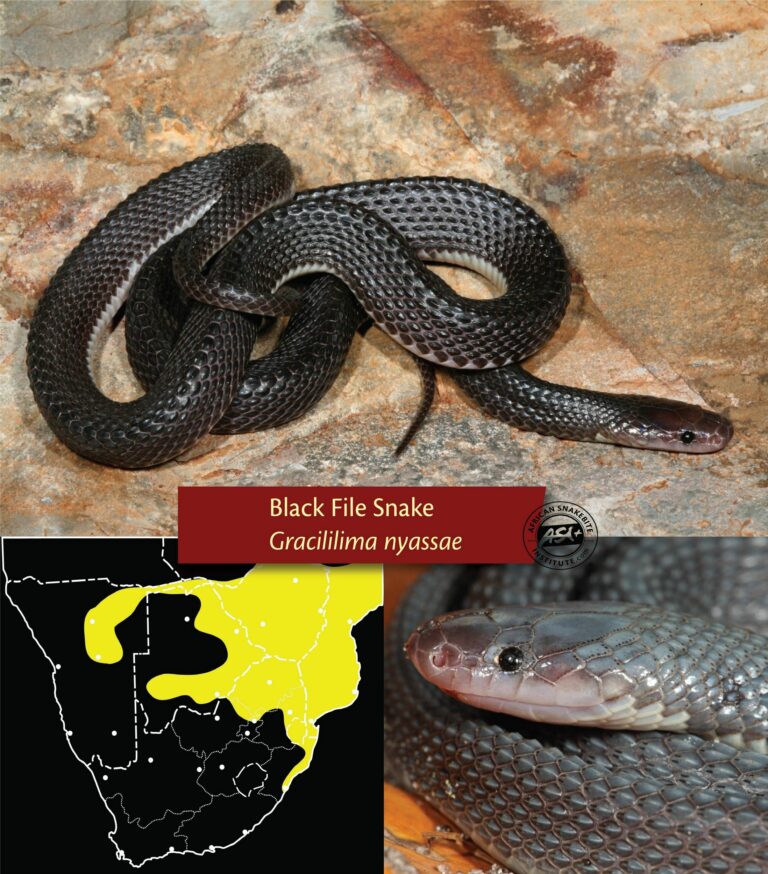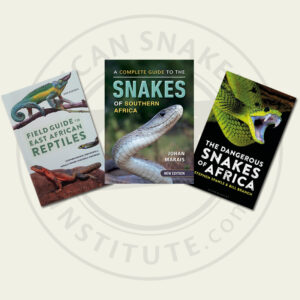Want to attend the course but can’t make it on this date?
Fill in your details below and we’ll notify you when we next present a course in this area:
The small black snakes, which are found across Africa, are tricky to learn to identify. The danger lies in the fact that most species are harmless or mildly venomous, but can be easily confused with the venomous stiletto snakes. Many people misidentify stiletto snakes and pick them up by hand, assuming they are harmless, and end up receiving bad bites leaving terrible wounds. There are currently 22 species of stiletto snakes across Africa with three species found in southern Africa and the Bibron’s Stiletto Snake being the most common and widespread species.
For many people, a small black snake is automatically a baby Black Mamba. Baby Black Mambas hatch between 45-60 cm and are light grey in colour and with some experience can easily be told apart from other small black snakes. For snake enthusiasts, learning to identify tricky groups such as the green snakes, sand snakes or small black snakes offers quite a challenge. If you are serious about learning more about these groups, the online ASI Advanced Snake ID course goes into great detail on these species and many others.
Although there are a large number of small black snakes such as young Olive Snakes (Lycodonomorphus inornatus), juvenile Black Spitting Cobras (Naja nigricincta woodi) and many of the Garter Snakes (Elapsoidea spp.), we are going to focus on the smaller species that typically live underground or come out at night, and which have a similar body profile.
There are six snakes in this group that often seem to confuse people. They are all dark brown or black in colour, but Bibron’s Stiletto Snake, Common Wolf Snakes and Black File Snakes may also be found with a distinct white belly, which extends slightly up the sides of the body, making these three difficult to tell apart. Many of these snakes may also attempt to hide their head under body coils and move in erratic or twitchy movements.
These snakes are all small, usually under 80 cm (although Natal Black Snakes and Common Purple-glossed Snakes may grow to near 1.2m in length) usually with quite indistinct head shapes and small black eyes in most species. The majority of these snakes occur in the eastern half of the region and distribution often helps when identifying these black snakes.

Common Purple-glossed Snake (Amblyodipsas polylepis)
A secretive snake that spends the majority of its life underground hunting frogs and reptiles. They may be seen moving on the surface after heavy rains, usually active at night or on overcast days, when out hunting large legless skinks. They are bulky and dark brown to purplish or black in colour. The head is chunky with large scales on the upper lips (upper labial scales). Notably, the 5th upper labial scale is greatly enlarged. The tail is also short and stubby in this species. They are widespread in the eastern half of southern Africa. The venom of this snake is not well studied but is not considered dangerous to humans.

Bibron’s Stiletto Snake (Atractaspis bibronii)
A secretive snake that largely lives underground but may be found under rocks. It may emerge at night, especially after rains. It hunts small reptiles including other snakes. They are brown to purplish-brown or black and sometimes have distinct white bellies that extend up the sides. This is an elongate snake and usually not as bulky as the Common Purple-glossed Snake. The head is more pointed and the tail usually ends in a tapered spike. They are widespread over much of southern Africa, avoiding the south-western regions. This is a venomous snake that bites by hinging a fang out the side of the mouth – meaning it cannot be safely caught or held behind the head. Bites are common, usually as a result of stepping on them barefoot at night or attempting to pick them up. The venom causes intense pain, swelling and blistering and often leads to tissue damage that may require skin grafts or, in severe cases, amputation of fingers. There is no antivenom and bites are treated symptomatically.

Natal Black Snake (Macrelaps microlepidotus)
An endemic snake to South Africa, largely restricted to forest patches in KwaZulu-Natal and the Eastern Cape. It is a slow-moving snake that lives in leaf litter and in tunnels around the roots of trees. It feeds on small reptiles and rodents as well as frogs, especially Rain Frogs. As the name suggests, these snakes are black in colour with white skin between the scales that is more visible in larger adults. They may turn a silvery-blue colour just before shedding. It is a bulky snake with a blunt head and a long, thin tail. The venom is not well-known as this docile snake hardly ever bites. It is not expected to be dangerous, but may cause some swelling and pain.

Natal Purple-glossed Snake (Amblyodipsas concolor)
A secretive snake that lives in grasslands as well as coastal forested areas. It is not often seen but may be found under rocks or active after heavy rains. They feed on smaller snakes and lizards. This snake is uniform black to purplish-brown in colour with a long, thin tail. They occur along the east coast into Eswatini and north to the Wolkberg in Limpopo. The venom is not well-known as this docile snake hardly ever bites. It is not expected to be dangerous, but a bite may cause some swelling and pain.

Black File Snake (Gracililima nyassae)
A secretive snake that is not commonly seen. It is quite easy to identify by the characteristic enlarged row of keeled scales down the centre of the back and the triangular body shape. The tail is notably long and thin. The head is elongate with a square snout. Black File Snakes are black to purplish-brown in colour with light pinkish skin between the scales and on the snout. The underside may be black or clean white that extends slightly up the sides. They feed on small lizards as well as other snakes. They occur across the north-eastern parts of southern Africa reaching Durban in the south. They are completely harmless but often musk, secreting a foul-smelling liquid if handled.

Common Wolf Snake (Lyocphidion capense)
A widespread and somewhat common snake. They are nocturnal and often enter the house at night or may be found under rocks and logs during the day. They are brownish to black in colour, usually with a pale speck on the edge of each scale, creating a speckled or chequered effect. Some individuals may have distinct white bellies that extend up the sides of the body. The head is flattened with a square snout and distinct, large grey to brownish eyes. They feed on smooth-scaled skinks and have enlarged teeth at the front of the mouth used to hold onto the skinks whilst they constrict. They are widespread over much of southern Africa avoiding the west coast of South Africa and parts of the Karoo. They are docile and completely harmless.
These small snakes are tricky to tell apart and must be treated with caution so as not to mix them up with the venomous Stiletto Snake. Head structure and scales, tail length and shape, distribution and colour are all good factors to assist with identification.

CONTACT US:
Product enquiries:
Caylen White
+27 60 957 2713
info@asiorg.co.za
Public Courses and Corporate training:
Michelle Pretorius
+27 64 704 7229
courses@asiorg.co.za
 ASI Book Combo 2
ASI Book Combo 2
 Rangers Book Combo 2
Rangers Book Combo 2
 ASI Collapsible Snake Hook - 1.2 m
R650.00
ASI Collapsible Snake Hook - 1.2 m
R650.00
Want to attend the course but can’t make it on this date?
Fill in your details below and we’ll notify you when we next present a course in this area:
Want to attend the course but can’t make it on this date?
Fill in your details below and we’ll notify you when we next present a course in this area:
Want to attend the course but can’t make it on this date?
Fill in your details below and we’ll notify you when we next present a course in this area:
Want to attend the course but can’t make it on this date?
Fill in your details below and we’ll notify you when we next present a course in this area:
Want to attend the course but can’t make it on this date?
Fill in your details below and we’ll notify you when we next present a course in this area:
Want to attend the course but can’t make it on this date?
Fill in your details below and we’ll notify you when we next present a course in this area:
Want to attend the course but can’t make it on this date?
Fill in your details below and we’ll notify you when we next present a course in this area:
Want to attend the course but can’t make it on this date?
Fill in your details below and we’ll notify you when we next present a course in this area:
Want to attend the course but can’t make it on this date?
Fill in your details below and we’ll notify you when we next present a course in this area:
Sign up to have our free monthly newsletter delivered to your inbox:
Before you download this resource, please enter your details:
Before you download this resource, would you like to join our email newsletter list?